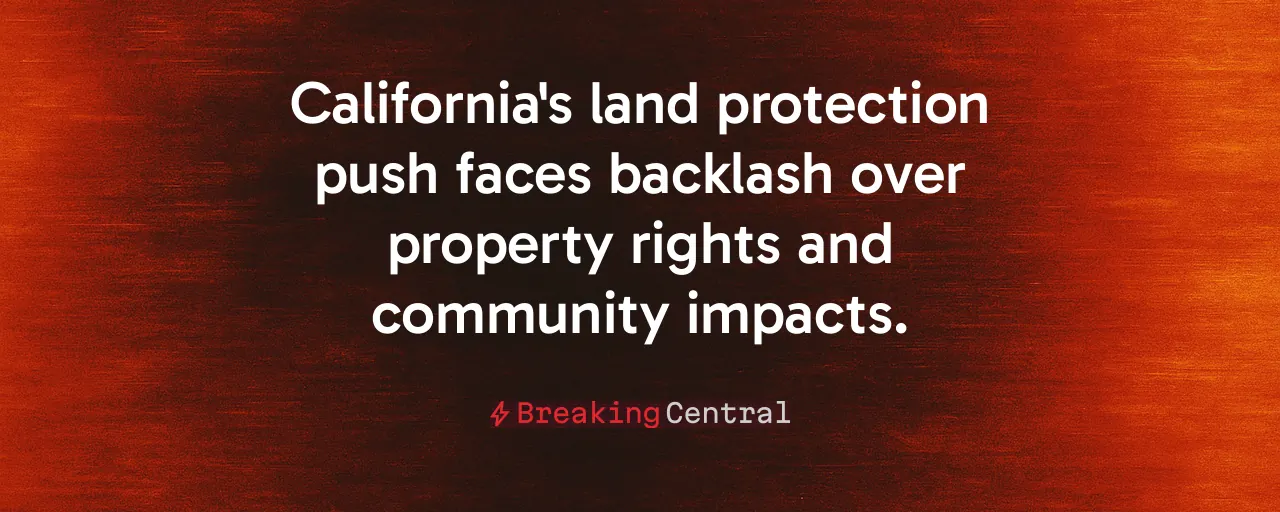A Million Acres Locked Away
California's government just announced a major milestone. Over one million acres of land and coastal waters were added to conserved areas in the past year, pushing the state closer to its goal of protecting 30 percent of its lands and waters by 2030. The effort, led by Governor Gavin Newsom, is being celebrated as a win for nature. Questions arise about whether this initiative truly prioritizes saving wildlife or if it is a power play that sidelines property owners and rural communities?
The state's 2025 progress report claims 26.1 percent of California's land and 21.9 percent of its coastal waters are now under long-term protection. That's an area the size of Glacier National Park added in just 12 months. Supporters say it's a bold step to fight climate change and preserve biodiversity. Yet the plan's rapid pace and top-down approach have sparked unease among landowners, farmers, and local governments who feel their voices are being ignored.
The 30x30 initiative, launched in 2020, extends beyond environmental concerns, touching every corner of California's economy and way of life. From timber workers in the Sierra to ranchers in the Central Valley, people are asking: who pays the price for this green vision? And why does it seem like Sacramento calls all the shots?
Property Rights Under Fire
Private property is a cornerstone of freedom. But California's conservation push often feels like a land grab to those who own the fields and forests. The state's plan relies heavily on easements and acquisitions, which can limit what landowners do with their property. While some view these as voluntary deals with tax benefits, others experience them as regulatory straitjackets that devalue their land and livelihoods.
Take rural counties, where timber and agriculture drive the economy. When land gets locked into conservation, local governments lose property tax revenue. In 2024, some counties reported millions in lost income from timber harvests alone. These are communities already struggling with tight budgets. Adding more protected acres without clear funding to offset losses leaves schools and services on the chopping block.
Then there's the housing crisis. California's desperate for homes, yet setting aside vast tracts for conservation makes developable land scarcer and pricier. The state's own data shows a shortfall of over 2 million homes. By prioritizing nature over people, 30x30 risks making it harder for families to afford a place to live.
Wildfires Expose Flaws
Despite conservation efforts aimed at protecting nature, California's forests continue to burn. The state spent over $4 billion fighting wildfires in 2024, yet poorly managed public lands fueled the flames. Federal studies confirm what locals already know: thinning forests and using prescribed burns cuts megafire risk far better than locking land away. The 30x30 initiative's focus on acreage over active management leaves fuel loads untouched.
Many conserved areas lack the staff or funds to maintain them. Overgrown forests and grasslands become tinderboxes, threatening nearby towns. The Karuk Tribe's recent agreement to use cultural burning is a step forward, but it's a drop in the bucket. Without widespread, practical land management, new conservation designations are little more than symbolic gestures.
Peer-reviewed research demonstrates that well-managed landscapes store more carbon and cost less to protect from fire. California's leaders talk a big game about climate resilience, but their priorities seem stuck on hitting a percentage target instead of solving real problems.
A Better Way Forward
Conservation can be achieved without imposing excessive control. There's a smarter path that respects property rights and boosts local economies. Voluntary easements, where landowners are paid to preserve habitat while keeping their land productive, work well. Studies show these deals protect biodiversity without killing jobs. Expanding tax credits for private stewardship could encourage more farmers and ranchers to join in.
Money from the new $10 billion climate bond could harden communities against wildfires instead of just buying more land. Grants for rural counties to replace lost tax revenue would ease tensions. And requiring legislative approval for big conservation designations would ensure transparency, unlike the current executive-driven process.
Tribal partnerships, like the Karuk's fire management deal, show promise. Scaling these up respects Native knowledge while addressing wildfire risks. The goal is to make conservation practical, accountable, and fair for everyone.
Balancing Nature and People
California's 30x30 plan is at a crossroads. Its backers see a legacy of protected landscapes for future generations. However, the costs, economic, social, and practical, cannot be ignored. Landowners, rural communities, and taxpayers deserve a seat at the table, not just a press release celebrating another million acres.
The state's own numbers prove progress is possible, even without heavy-handed mandates. Flexible easements and active forest management can deliver ecological wins while keeping rural economies alive. Redirecting funds to fire prevention and community support would demonstrate Sacramento's commitment to people as well as parks.
Conservation is a shared goal; it requires respect for the people who live and work on the land. California can lead by prioritizing balance and avoiding bureaucracy, demonstrating that nature and prosperity can coexist.
